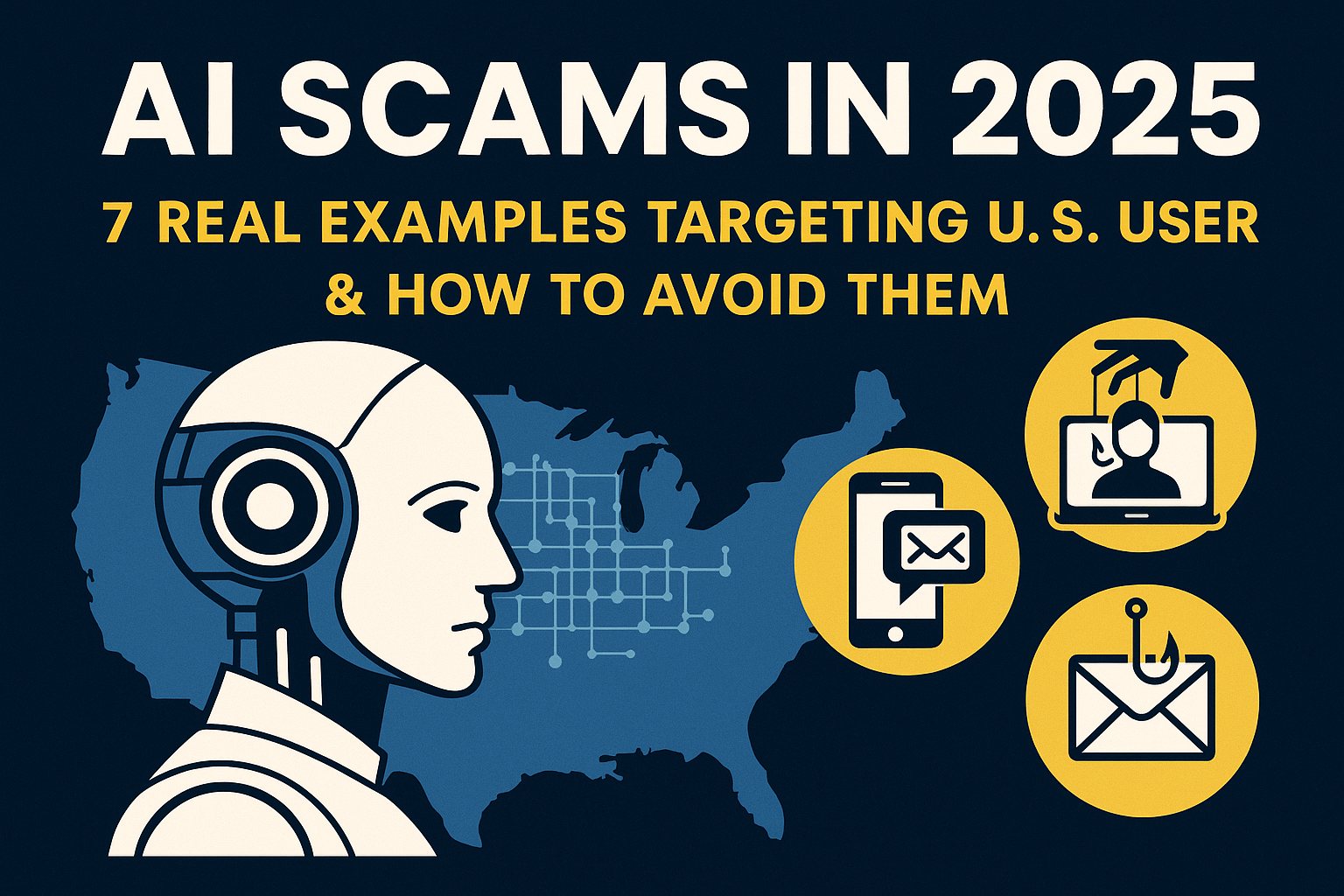AI Scams in 2025: 7 Real Examples and How to Avoid Them
AI scams in 2025 are evolving faster than most Americans realize. From deepfake impersonations to AI-generated phishing emails, scammers are using artificial intelligence to exploit U.S. users in ways that are harder to detect than ever before. In this post, we’ll break down 7 real AI scams targeting Americans in 2025 — and exactly how to avoid falling victim to them.

Table of Contents
✅ Why AI Scams Are a Big Deal in the U.S. in 2025
In 2025, the rise of generative AI tools like ChatGPT, voice clones, and synthetic media has given scammers new ways to bypass traditional cybersecurity defenses. U.S. consumers, especially seniors and remote workers, are top targets because of widespread digital activity and patchy regulation.
Whether it’s an AI voice mimicking your family member or an email that looks like it came from your bank, the threat is real. Here’s how it’s happening now.
Want a quick visual version ? Swipe this webstory
🔍 7 Real AI Scams in 2025 Targeting Americans
1. 🎙️ AI Voice Scams (“Grandparent Scam 2.0”)
Scammers clone a loved one’s voice using public audio or social media. Then they call victims — often seniors — pretending to be in trouble and asking for urgent money transfers.
🛡️ Avoid It: Always verify by calling the person back on a known number. Use a “safe word” that only family members know.
2. 📧 AI-Generated Phishing Emails
AI now writes highly convincing phishing emails using U.S. bank names, IRS references, or fake job offers. These messages are grammatically perfect and hard to detect.
🛡️ Avoid It: Hover over email links before clicking, and use email filters like SaneBox or ProtonMail.
3. 💼 Deepfake Job Interviews
AI-powered video scams trick job seekers into fake interviews using deepfake recruiters. They collect sensitive info like SSNs or bank details under the guise of onboarding.
🛡️ Avoid It: Research the company independently. Never share private details before confirming legitimacy.
4. 🛍️ AI Chatbot Shopping Scams
Fake retail chatbots on U.S. e-commerce sites mimic real customer service agents and steal payment info or login credentials.
🛡️ Avoid It: Stick to known retailers and avoid clicking links sent by chatbots without verifying them.
5. 📱 AI Text Scams (Smishing)
Automated AI systems send personalized SMS messages, appearing to be from FedEx, banks, or the IRS. They often contain malicious links or fake login pages.
🛡️ Avoid It: Don’t click links in unsolicited texts. Verify messages by logging into the official website directly.
6. 💳 AI-Powered Investment Scams
Scammers use AI to scrape U.S. investor data and send personalized pitches promising “guaranteed” crypto or stock returns. Many use AI-generated fake websites and testimonials.
🛡️ Avoid It: No investment is guaranteed. Research using trusted sources like FINRA or the SEC’s EDGAR tool.
7. 🎥 Deepfake Celebrity Endorsements
AI-generated videos feature celebrities like Elon Musk or Oprah promoting scam investments or “miracle” products.
🛡️ Avoid It: Cross-check offers on Snopes, and assume any celebrity pitch is fake unless it comes from verified social media.
🧠 How to Spot AI Scams in 2025
Check for too-perfect grammar in emails
Use reverse image search to identify fake photos
Always confirm voice/video calls with a second channel (text or email)
Enable multi-factor authentication (MFA) on financial accounts
Use security tools like Bitdefender Mobile Security or Malwarebytes Premium
U.S.-Specific Tips to Stay Safe
Beware of scams impersonating U.S. government agencies like the IRS, FBI, or Social Security
Don’t trust job offers or prize winnings that require payment or personal info upfront
Use a VPN like Surfshark or Proton VPN to hide your location and reduce tracking
Check suspicious activity at identitytheft.gov (official FTC site)
🛡️ Final Thoughts: Don’t Let AI Outsmart You
AI scams in 2025 are getting more personal, more convincing, and more dangerous — especially for U.S. users. But you can outsmart them by staying informed, skeptical, and protected with the right tools and habits.
✅ Recommended Tools:
Email Protection: SaneBox
Mobile Security: Bitdefender, Malwarebytes
VPN for Anonymity: Proton VPN, Surfshark
Secure Messaging: Signal
Also read :
Best Secure Messaging Apps for U.S. Users in 2025: Signal, WhatsApp, or Telegram

Pingback: Spot AI‑Generated Phishing Emails in 2025
Wow, superb blog layout! How long have you been blogging for?
you made blogging look easy. The overall look of your website is fantastic,
let alone the content!
Thank you so much for your kind words! I actually took a fresh start with blogging a little over 2 months ago, and it’s been an exciting journey so far. I’m glad you enjoyed both the content and the layout—your encouragement really means a lot!
Whats up very cool site!! Man .. Beautiful .. Superb .. I will bookmark your blog and take the feeds additionally?
I am glad to find numerous helpful information right here within the post, we need develop more strategies on this regard, thanks
for sharing. . . . . .
It’s very easy to find out any topic on web as compared to textbooks, as I found this post at this
site.
Thank you so much for your kind words! I’m glad you enjoyed the post. Your encouragement really means a lot and motivates me to keep sharing more.
Thank you! I’m thrilled to hear you enjoyed the post. Comments like yours make blogging even more rewarding.
Right here is the perfect site for everyone who really wants to find out
about this topic. You know a whole lot its almost tough to
argue with you (not that I really would want to…HaHa).
You certainly put a fresh spin on a topic which has been discussed for decades.
Wonderful stuff, just wonderful!
Thank you so much for your kind words! I’m glad you enjoyed the post. Your encouragement really means a lot and motivates me to keep sharing more.
Hello everybody, here every person is sharing
such experience, therefore it’s fastidious to read this blog, and I used to go
to see this weblog everyday.
Thanks so much for your feedback! I’m glad you enjoyed the post.